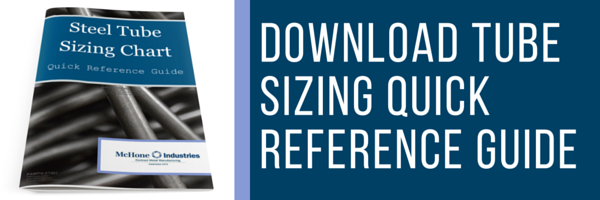
If there’s one thing we know, it’s metal tubing.
A versatile material, metal tubing of all shapes and sizes are all around you, from your bed frame to the support beams in the building you’re in.
If you’re looking at metal tubing for a project, understanding what goes into getting the right pieces may be a bit … overwhelming. There’s a lot to consider, after all.
To make things easier for you, we’ve created a handy steel tubing sizes chart you can download for free (we’ve also included a sample below). It covers all the bases for our capabilities so you can make the right decision about metal tubing the first time.
Standard Steel Tubing Sizes Chart: The Basics
Before diving headfirst into our chart, let’s first spend some time on its basics.
In specifying metal or steel tubing, there are four key components to making sure you order the correct piece(s):
- Shape
- Dimensions
- Thickness
- Weight
Each of these attributes impact a tube’s:
- Strength
- Durability
- Machinability
- Formability
If this is your first time designing or specifying tubing metal fabrication, you should be familiar with how dimensions, thickness, and weight affect manufacturing and your end product.
Related: Comprehensive Tube Bending Design Guide
Let’s explore each attribute and what it means for your project.
1. Shape
The shape of metal tubing is the best place to start. Having the right shaped tube for your project means you’ll have a piece that fits. In other words, you won’t be trying to fit a square peg in a round hole, so to speak.
Most metal manufacturers offer tubing in these standard shapes:
- Round
- Oval
- Square
- Rectangular
- "D"
Common non-standard shapes include:
- Triangle
- Hexagonal
- Shapes with inverted corners.
2. Outer Dimensions
Tubing is measured by outer dimensions -- or tubing diameter OD. Pipe, on the other hand, is specified by schedule/nominal thickness and inner diameter, or pipe diameter ID. Read more about the difference between tube and pipe here.
Outer dimensions range from .5" to 2.5". Outer dimension refers to the diameter of the tube starting at the outer wall. Available widths will vary by tube shape.
3. Thickness
Wall thickness, or gauge, indicates the thickness of a tube's wall.
Wall thickness affects the strength, weight, and formability of a tube. Thickness ranges from .024" to .085". Available gauge options typically vary depending on the tube shape and dimension you want. Wall thickness is commonly measured in inches or millimeters, while standard gauge is measured in integers (e.g., 18 gauge).
You may be able to cut costs by optimizing your tubular steel product design.
4.Weight
Density and weight are important for accurate total cost calculations -- including shipping costs. If you need a certain amount of strength for your part but have weight or cost restrictions, your manufacturer can work with you to find a solution.
Weight is measured in pounds per foot. This number indicates the heaviness of a tube using outer dimension and gauge.
Sample Steel Tubing Size Chart
Square Tubing
|
Outer Dimension (Inches) |
Gauge (Inches) |
Wall Thickness (Inches) |
|
0.500 |
22 gauge |
0.020 |
|
20 gauge |
0.035 |
|
|
18 gauge |
0.049 |
|
|
16 gauge |
0.065 |
|
|
0.625 |
22 gauge |
0.020 |
|
20 gauge |
0.035 |
|
|
18 gauge |
0.049 |
|
|
16 gauge |
0.065 |
|
|
0.750 |
22 gauge |
0.020 |
|
20 gauge |
0.035 |
|
|
18 gauge |
0.049 |
|
|
16 gauge |
0.065 |
|
|
0.812 |
22 gauge |
0.020 |
|
20 gauge |
0.035 |
|
|
18 gauge |
0.049 |
|
|
16 gauge |
0.065 |
|
|
14 gauge |
0.083 |
*As long as the tube dimensions are 2” x 2” or under, we can manufacture any shape you need.
Download the full chart here:
Popular Types of Metal Tubing
In our experience, customers typical opt for these three types of metal tubing:
Here are the stats on each:
(Key: OD = outer dimension; WT = wall thickness; LS = long side; SS = short side)
MILD CARBON STEEL
- Density: .284 lb./cubic in.
- Round tubing weight: 10.7 x (OD - WT) x WT
- Square weight: 13.63 x (OD x WT) x WT
- Rectangular weight: 13.63 x [(LS + SS / 2) - WT] x WT
304 STAINLESS STEEL
- Density: .289 lb./cubic in.
- Round tubing weight: 10.93 x (OD - WT) x WT
- Square weight: 13.92 x (OD x WT) x WT
- Rectangular weight: 13.92 x [(LS + SS / 2) - WT] x WT
6061 ALUMINUM
- Density: .098 lb./cubic in.
- Round tubing weight: 3.69 x (OD - WT) x WT
- Square weight: 4.704 x (OD x WT) x WT
- Rectangular weight: 4.704 x [(LS + SS / 2) - WT] x WT
Selecting Metal Tubing for Your Project
Understanding the basics of tube sizes is about more than measures and dimensions. With a solid grasp of how tubing size impacts the key components we explored, you’ll have confidence in your final product.
One other word of advice: Tube sizing and fabrication capabilities vary by manufacturer. If you a metal shop doesn’t offer the size or shape you need, don’t make sacrifices. Rather, find a metal manufacturer that’s able to accommodate your project’s metal tubing needs.
Ps., If you have any questions about tubing sizes or this chart, feel free to contact us directly.
(Editor's Note: This article was originally posted in April 2017 and was recently updated.)



